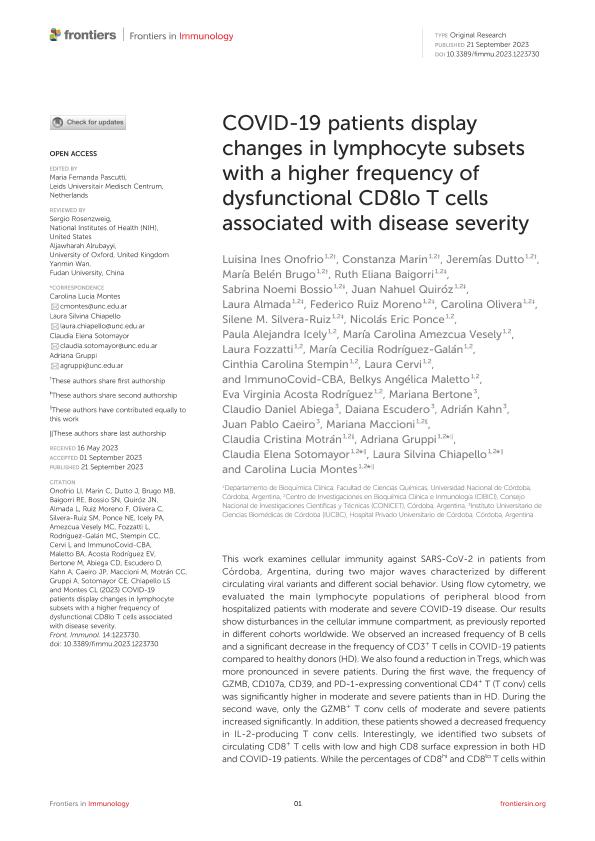Artículo
COVID-19 patients display changes in lymphocyte subsets with a higher frequency of dysfunctional CD8lo T cells associated with disease severity
Onofrio, Luisina Inés ; Marin, Constanza
; Marin, Constanza ; Dutto, Jeremias
; Dutto, Jeremias ; Brugo, María Belén
; Brugo, María Belén ; Baigorri, Ruth Eliana
; Baigorri, Ruth Eliana ; Bossio, Sabrina Noemí
; Bossio, Sabrina Noemí ; Quiroz, Juan Nahuel
; Quiroz, Juan Nahuel ; Almada, Laura
; Almada, Laura ; Ruiz Moreno, Federico Nahuel
; Ruiz Moreno, Federico Nahuel ; Olivera, Carolina
; Olivera, Carolina ; Silvera Ruiz, Silene Maite
; Silvera Ruiz, Silene Maite ; Ponce, Nicolás Eric
; Ponce, Nicolás Eric ; Icely, Paula Alejandra
; Icely, Paula Alejandra ; Amezcua Vesely, Maria Carolina
; Amezcua Vesely, Maria Carolina ; Fozzatti, Laura
; Fozzatti, Laura ; Rodriguez Galan, Maria Cecilia
; Rodriguez Galan, Maria Cecilia ; Stempin, Cinthia
; Stempin, Cinthia ; Cervi, Laura Alejandra
; Cervi, Laura Alejandra ; Maletto, Belkys Angélica
; Maletto, Belkys Angélica ; Acosta Rodriguez, Eva Virginia
; Acosta Rodriguez, Eva Virginia ; Bertone, Mariana; Abiega, Claudio Daniel; Escudero, Daiana; Kahn, Adrian Mario; Caeiro, Juan Pablo; Maccioni, Mariana
; Bertone, Mariana; Abiega, Claudio Daniel; Escudero, Daiana; Kahn, Adrian Mario; Caeiro, Juan Pablo; Maccioni, Mariana ; Motran, Claudia Cristina
; Motran, Claudia Cristina ; Gruppi, Adriana
; Gruppi, Adriana ; Sotomayor, Claudia Elena
; Sotomayor, Claudia Elena ; Chiapello, Laura Silvina
; Chiapello, Laura Silvina ; Montes, Carolina Lucia
; Montes, Carolina Lucia
 ; Marin, Constanza
; Marin, Constanza ; Dutto, Jeremias
; Dutto, Jeremias ; Brugo, María Belén
; Brugo, María Belén ; Baigorri, Ruth Eliana
; Baigorri, Ruth Eliana ; Bossio, Sabrina Noemí
; Bossio, Sabrina Noemí ; Quiroz, Juan Nahuel
; Quiroz, Juan Nahuel ; Almada, Laura
; Almada, Laura ; Ruiz Moreno, Federico Nahuel
; Ruiz Moreno, Federico Nahuel ; Olivera, Carolina
; Olivera, Carolina ; Silvera Ruiz, Silene Maite
; Silvera Ruiz, Silene Maite ; Ponce, Nicolás Eric
; Ponce, Nicolás Eric ; Icely, Paula Alejandra
; Icely, Paula Alejandra ; Amezcua Vesely, Maria Carolina
; Amezcua Vesely, Maria Carolina ; Fozzatti, Laura
; Fozzatti, Laura ; Rodriguez Galan, Maria Cecilia
; Rodriguez Galan, Maria Cecilia ; Stempin, Cinthia
; Stempin, Cinthia ; Cervi, Laura Alejandra
; Cervi, Laura Alejandra ; Maletto, Belkys Angélica
; Maletto, Belkys Angélica ; Acosta Rodriguez, Eva Virginia
; Acosta Rodriguez, Eva Virginia ; Bertone, Mariana; Abiega, Claudio Daniel; Escudero, Daiana; Kahn, Adrian Mario; Caeiro, Juan Pablo; Maccioni, Mariana
; Bertone, Mariana; Abiega, Claudio Daniel; Escudero, Daiana; Kahn, Adrian Mario; Caeiro, Juan Pablo; Maccioni, Mariana ; Motran, Claudia Cristina
; Motran, Claudia Cristina ; Gruppi, Adriana
; Gruppi, Adriana ; Sotomayor, Claudia Elena
; Sotomayor, Claudia Elena ; Chiapello, Laura Silvina
; Chiapello, Laura Silvina ; Montes, Carolina Lucia
; Montes, Carolina Lucia
Fecha de publicación:
09/2023
Editorial:
Frontiers Media
Revista:
Frontiers in Immunology
e-ISSN:
1664-3224
Idioma:
Inglés
Tipo de recurso:
Artículo publicado
Clasificación temática:
Resumen
This work examines cellular immunity against SARS-CoV-2 in patients from Córdoba, Argentina, during two major waves characterized by different circulating viral variants and different social behavior. Using flow cytometry, we evaluated the main lymphocyte populations of peripheral blood from hospitalized patients with moderate and severe COVID-19 disease. Our results show disturbances in the cellular immune compartment, as previously reported in different cohorts worldwide. We observed an increased frequency of B cells and a significant decrease in the frequency of CD3+ T cells in COVID-19 patients compared to healthy donors (HD). We also found a reduction in Tregs, which was more pronounced in severe patients. During the first wave, the frequency of GZMB, CD107a, CD39, and PD-1-expressing conventional CD4+ T (T conv) cells was significantly higher in moderate and severe patients than in HD. During the second wave, only the GZMB+ T conv cells of moderate and severe patients increased significantly. In addition, these patients showed a decreased frequency in IL-2-producing T conv cells. Interestingly, we identified two subsets of circulating CD8+ T cells with low and high CD8 surface expression in both HD and COVID-19 patients. While the percentages of CD8hi and CD8lo T cells within the CD8+ population in HD are similar, a significant increase was observed in CD8lo T cell frequency in COVID-19 patients. CD8lo T cell populations from HD as well as from SARS-CoV-2 infected patients exhibited lower frequencies of the effector cytokine-producing cells, TNF, IL-2, and IFN-γ, than CD8hi T cells. Interestingly, the frequency of CD8lo T cells increased with disease severity, suggesting that this parameter could be a potential marker for disease progression. Indeed, the CD8hi/CD8lo index helped to significantly improve the patient’s clinical stratification and disease outcome prediction. Our data support the addition of, at least, a CD8hi/CD8lo index into the panel of biomarkers commonly used in clinical labs, since its determination may be a useful tool with impact on the therapeutic management of the patients.
Archivos asociados
Licencia
Identificadores
Colecciones
Articulos(CIBICI)
Articulos de CENTRO DE INV.EN BIOQUI.CLINICA E INMUNOLOGIA
Articulos de CENTRO DE INV.EN BIOQUI.CLINICA E INMUNOLOGIA
Citación
Onofrio, Luisina Inés; Marin, Constanza; Dutto, Jeremias; Brugo, María Belén; Baigorri, Ruth Eliana; et al.; COVID-19 patients display changes in lymphocyte subsets with a higher frequency of dysfunctional CD8lo T cells associated with disease severity; Frontiers Media; Frontiers in Immunology; 14; 1223730; 9-2023; 1-14
Compartir
Altmétricas



